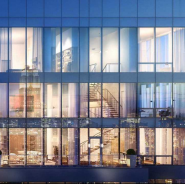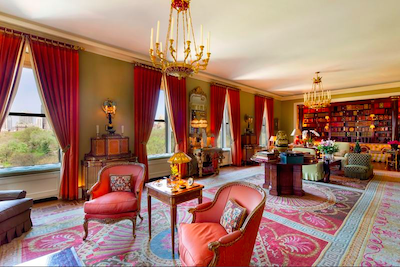 Flatiron penthouse for sale via StreetEasy
Flatiron penthouse for sale via StreetEasy
Price growth in New York’s luxury homes is continuing to flat line, according to StreetEasy’s April report.
StreetEasy’s monthly reports have shown stagnation or decline in the median resale price of New York homes since October 2015, even as the number of homes priced in the segment remained the same year-over-year. Although the investment capabilities of New York real estate have contributed to it being viewed as something of a bubble, the city has been swept into a larger luxury real estate slowdown.
"There will always be an ebb and flow to demand for Manhattan luxury real estate, however great that investment may be. In 2014 and 2015, the overall market saw incredible growth that simply could not be sustained," said Alan Lightfeldt, data scientist at StreetEasy. "As demand has tapered off a bit, price growth has cooled and the market has slowed.
"None of this is concerning from a market perspective, as we expect growth to cool after a strong rally," he said. "It is important to note that slower price growth is not the same thing as a market crash.”
Safe investment?
Overall, New York real estate prices are appreciating, but this is due primarily to a shortage of inventory – declining 25 percent – in the bottom 40 percent of the market, or homes costing less than $1.05 million, in the Manhattan borough. Those priced in the upper 20 percent (more than $3.31 million in Manhattan or $1.33 million in Brooklyn) are continuing to falter.
Throughout the year, real estate will continue to trend downward, with the luxury quintile leading the citywide deceleration in price growth. Currently, the luxury quintile is faced with over-supply while affordable homes are at a shortage. The market will have to achieve equilibrium before the high-end can expect to grow again.
 Lenox Hill co-op for sale via StreetEasy
"The conflicting price trends happening among luxury and non-luxury homes in Manhattan hints at a rather remarkable imbalance between demand and available supply," Mr. Lightfeldt said. "Manhattan buyers are by-and-large looking for moderately priced homes at or below the $1 million mark, but what they're finding on the market now is mostly luxury units priced well above that.
"Developers raced to get these luxury units to market while demand for them peaked in 2014 and 2015. Since then, however, demand at the high-end of the market has flagged while it remains high at the middle to low end.”
However, units at the very top of the market, because of perpetually short supply, are immune to this trend. The continued interest in New York’s most expensive speaks to the continued safety of investment in the city’s real estate.
In the six-month period ending March 31, 2016, 566 apartments were sold in buildings comprising The CityRealty 100, the firm’s index of the top 100 condominium buildings. During the same period last year, there were only 334 sales.
Additionally, over the past 10 years, properties in The CityRealty 100 have had a 7 percent compound annual growth rate, significantly higher than the CAGR of oil, the S&P 500 and the wealth of Forbes’ top 100 billionaires.
CityRealty 100 video
While the strengthening of the U.S. dollar might be expected to deter foreign buyers from high-end New York real estate, this effect is somewhat overstated: such buyers are usually drawn to the properties for their stability compared to other investment options, not to maximize their yield.
"The continued high rate of return on luxury Manhattan condos indicates that New York City real estate continues to be a strong investment for international and domestic investors," said Gabby Warshawer, director of research for CityRealty. "It has long been viewed as a sound investment, and it’s valued both by buyers who are looking for long-term returns as well as for buyers who prioritize maximum yield.
"This report, which shows the CAGR for the CityRealty 100 index outperforming both oil and the S&P 500 and nearly matching the CAGR for gold, underscores that Manhattan luxury real estate is a gold standard asset for global investors.”
At the same time, those looking for second homes may be looking to Australia, Canada or elsewhere, where exchange rates are more favorable, rather than New York. The economic volatility over the past year, beginning while many luxury buildings were in development, may therefore contribute to the over-supply.
Global changes
Indeed, real estate advisors believe that foreign buyers purchase at least a quarter of Canadian luxury properties, according to a new report from Royal LePage.
When asked about changes in the market, two-thirds of advisors say foreign buyer activity has increased, with 24 percent saying foreign buyers account for at least 25 percent of properties. Canada’s culture, laws and currency suggest that the trend will continue throughout the year (see story).
New York is not the only major player that has seen real estate values decline. Both within the U.S. and globally, legacy cities known for high values are seeing emergent hubs surpass their growth.
Stagnation in the luxury real estate market of the world’s biggest cities is counterbalanced by the emergence of new hubs, according to a recent report by Christie’s International Real Estate.
London and New York have slowed down recently, but less prominent markets that were slower recovering from the recession are continuing to perform admirably. With the post-recession boom over, exchange rates and a host of other political and financial concerns have shaken up the market, creating opportunities and challenges heavily dependent on geography (see story).
In New York, that slowdown will continue until supply and demand re-align.
"The supply-demand imbalance in the Manhattan market is troubling," Mr. Lightfeldt said. "It is creating very heated competition for moderately to lower priced homes, while luxury homes suffer from longer time on market and declining prices.
"Until supply and demand begin to align, we expect further declines among luxury properties and perhaps even stronger competition to swell for homes under $1 million,” he said.
Lenox Hill co-op for sale via StreetEasy
"The conflicting price trends happening among luxury and non-luxury homes in Manhattan hints at a rather remarkable imbalance between demand and available supply," Mr. Lightfeldt said. "Manhattan buyers are by-and-large looking for moderately priced homes at or below the $1 million mark, but what they're finding on the market now is mostly luxury units priced well above that.
"Developers raced to get these luxury units to market while demand for them peaked in 2014 and 2015. Since then, however, demand at the high-end of the market has flagged while it remains high at the middle to low end.”
However, units at the very top of the market, because of perpetually short supply, are immune to this trend. The continued interest in New York’s most expensive speaks to the continued safety of investment in the city’s real estate.
In the six-month period ending March 31, 2016, 566 apartments were sold in buildings comprising The CityRealty 100, the firm’s index of the top 100 condominium buildings. During the same period last year, there were only 334 sales.
Additionally, over the past 10 years, properties in The CityRealty 100 have had a 7 percent compound annual growth rate, significantly higher than the CAGR of oil, the S&P 500 and the wealth of Forbes’ top 100 billionaires.
CityRealty 100 video
While the strengthening of the U.S. dollar might be expected to deter foreign buyers from high-end New York real estate, this effect is somewhat overstated: such buyers are usually drawn to the properties for their stability compared to other investment options, not to maximize their yield.
"The continued high rate of return on luxury Manhattan condos indicates that New York City real estate continues to be a strong investment for international and domestic investors," said Gabby Warshawer, director of research for CityRealty. "It has long been viewed as a sound investment, and it’s valued both by buyers who are looking for long-term returns as well as for buyers who prioritize maximum yield.
"This report, which shows the CAGR for the CityRealty 100 index outperforming both oil and the S&P 500 and nearly matching the CAGR for gold, underscores that Manhattan luxury real estate is a gold standard asset for global investors.”
At the same time, those looking for second homes may be looking to Australia, Canada or elsewhere, where exchange rates are more favorable, rather than New York. The economic volatility over the past year, beginning while many luxury buildings were in development, may therefore contribute to the over-supply.
Global changes
Indeed, real estate advisors believe that foreign buyers purchase at least a quarter of Canadian luxury properties, according to a new report from Royal LePage.
When asked about changes in the market, two-thirds of advisors say foreign buyer activity has increased, with 24 percent saying foreign buyers account for at least 25 percent of properties. Canada’s culture, laws and currency suggest that the trend will continue throughout the year (see story).
New York is not the only major player that has seen real estate values decline. Both within the U.S. and globally, legacy cities known for high values are seeing emergent hubs surpass their growth.
Stagnation in the luxury real estate market of the world’s biggest cities is counterbalanced by the emergence of new hubs, according to a recent report by Christie’s International Real Estate.
London and New York have slowed down recently, but less prominent markets that were slower recovering from the recession are continuing to perform admirably. With the post-recession boom over, exchange rates and a host of other political and financial concerns have shaken up the market, creating opportunities and challenges heavily dependent on geography (see story).
In New York, that slowdown will continue until supply and demand re-align.
"The supply-demand imbalance in the Manhattan market is troubling," Mr. Lightfeldt said. "It is creating very heated competition for moderately to lower priced homes, while luxury homes suffer from longer time on market and declining prices.
"Until supply and demand begin to align, we expect further declines among luxury properties and perhaps even stronger competition to swell for homes under $1 million,” he said.
